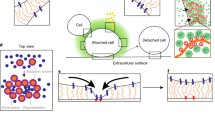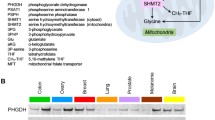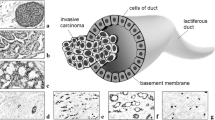Abstract
In this paper, we consider a direct protein transfer process between cells in co-culture. Assuming that cells continually encounter each other, and from some hypotheses on cell-to-cell rules of transfer, we derive discrete and continuous Boltzmann-like integro-differential equations. The novelty of this model is to take into account multiple transfer rules. This new transfer model is used to fit the experimental data of cell-to-cell protein transfer in breast cancer.






Similar content being viewed by others
References
Ambudkar SV, Sauna ZE, Gottesman MM, Szakacs G (2005) A novel way to spread drug resistance in tumor cells: functional intercellular transfer of P-glycoprotein (ABCB1). Trends Pharmacol Sci 26:385–387
Bellomo N, Delitala M (2008) From the mathematical kinetic, and stochastic game theory to modelling mutations, onset, progression and immune competition of cancer cells. Phys Life Rev 5:183–206
Bellomo N, Li N, Maini P (2008) On the foundations of cancer modelling selected topics, speculations, and perspectives. Math Models Methods Appl Sci 18:593–646
Bellouquid A, Delitala M (2006) Mathematical modeling of complex biological systems: a kinetic theory approach. Birkhäuser, Boston
Dale B, McNerney GP, Thompson DL, Hübner W, Huser T, Chen BK (2010) Visualizing cell-to-cell transfer of HIV using fluorescent clones of HIV and live confocal microscopy. JoVE 44
Davis DM et al (2003) The protean immune cell synapse: a supramolecular structure with many functions. Semin Immunol 15:317–324
Ducrot A, Le Foll F, Magal P, Murakawa H, Pasquier J, Webb GF (2011) An in vitro cell population dynamics model incorporating cell size, quiescence, and contact inhibition. Math Models Methods Appl Sci 21:871–892
Dudley ME, Rosenberg SA (2002) Adoptive-cell-transfer therapy for the treatment of patients with cancer. Nat Rev Cancer 3:666–675
Dudley ME et al (2005) Adoptive cell transfer therapy following non-myeloablative but lymphodepleting chemotherapy for the treatment of patients with refractory metastatic melanoma. J Clin Oncol 23:2346–2357
Hansen C, Angot E, Bergstrom AL, Steiner JA, Pieri L, Paul G, Outeiro TF, Melki R, Kallunki P, Fog K, Li JY, Brundin P (2011) \(\alpha \)-Synuclein propagates from mouse brain to grafted dopaminergic neurons and seeds aggregation in cultured human cells. J Clin Invest 121:715–725
Hinow P, Le Foll F, Magal P, Webb GF (2009) Analysis of a model for transfer phenomena in biological populations. SIAM J Appl Math 70:40–62
Levchenko A, Mehta BM, Niu X, Kang G, Villafania L, Way D, Polycarpe D, Sadelain M, Larson SM (2005) Intercellular transfer of P-glycoprotein mediates acquired multidrug resistance in tumor cells. Proc Natl Acad Sci USA 102:1933–1938
Novozhilov AS, Karev GP, Koonin E (2005) Mathematical modeling of evolution of horizontally transferred genes. Mol Biol Evol 22:1721–1732
Pasquier J, Magal P, Boulangé-Lecomte C, Webb G, Le Foll F (2011) Consequences of cell-to-cell P-glycoprotein transfer on acquired multidrug resistance in breast cancer: a cell population dynamics model. Biol Direct 6:5
Pasquier J, Galas L, Boulang-Lecomte C, Rioult D, Bultelle F, Magal P, Webb G, Le Foll F (2012) Different modalities of intercellular membrane exchanges mediate cell-to-cell P-glycoprotein transfers in MCF-7 breast cancer cells. J Biol Chem 287(10):7374–7387
Suhail Y, Lee J, Walker M, Kim DH, Brennan MD, Bader JS, Levchenko A (2013) Modeling intercellular transfer of biomolecules through tunneling nanotubes. Bull Math Biol 75(8):1400–1416
Villani C (2002) A review of mathematical topics in collisional kinetic theory. In: Friedlander S, Serre D (eds) Handbook of mathematical fluid dynamics, vol 1. North-Holland, Amsterdam, pp 71–305
Author information
Authors and Affiliations
Corresponding author
Appendix: Convergence of the Discrete Model to Continuous Model
Appendix: Convergence of the Discrete Model to Continuous Model
In this section, we show the convergence of the scheme (6). It means that the difference \(|u- u^\Delta |_1\) between the approximate solution \(u^\Delta \) of the discrete model (6) and the solution u of the continuous model (4) tends to zero as the meshsizes \(\Delta t, \Delta x\) go to zero (for simplicity we set \(\Delta t=r\Delta x\)). Here the approximate solution \(u^\Delta \) is defined as the piecewise constant function defined on \(]0, T[ \times \Omega _L\) (with \(\Omega _L:=[0,L]\))
where the values \(u^n_{i}\) are computed by (6).
Theorem 12
Let \( u_0\in (L^1\cap L^\infty )(\Omega _L)\) with total variation be bounded locally in \(\Omega _L\), \( u_0\ge 0\) , then as the meshsize \(\Delta x \) tends to zero, there is a subsequence of \({( u^{\Delta })}_{\Delta x>0}\), the family of approximate solution, converging in \(L^1_{loc}([0,T]\times \Omega _L)\) to a function \(u\in L^1_{loc}([0,T]\times \Omega _L)\).
The limiting function u(t, x) just obtained is a weak solution of the problem (1).
In order to prove Theorem 12, we first prove the existence of a limit u to \( u^{\Delta }\) when the meshsize \(\Delta x\) goes to zero. Then we prove that this limit is a solution of the continuous problem (1).
Existence of a limit for \(u^\Delta \) The proof of existence of the limit u(t, x) is based on the compact canonical imbedding from \(W^{1,1}(\Omega )\) into \(L^{1}(\Omega )\). Let \(I(u^\Delta )\), defined on \([0,T]\times \Omega _L\), be the interpolate of degree one of \(u^\Delta \) at the vertices of each rectangle \([x_i,x_{i+1}]\times [t_n,t_{n+1}]\) where it is given by
\(I(u^\Delta )\) is continuous with
and differentiable inside each rectangle. Thus, we obtain
In the same way,
On the other hand, one can check that the numerical scheme (6) satisfies the following a priori estimates
where \(C_1\) and \(C_2\) are two constants independent of n.
Let \( u_0\in L^\infty (\Omega _L)\), then \(\sup _i|u_i^0|\le C\). It follows that \(u^\Delta \) is bounded and then contains a subsequence \(u^{\Delta _p}\) weakly star convergent to a limit \(u\in L^\infty ([0,T]\times \Omega _L)\) bounded by \(|u_0|_L^\infty (\Omega _L)\).
Let \( u_0\) with the total variation \(TV(u_0(x))=\sum _{i=1}^{I_L} | u_{0}(x_{i+1})-u_{0}(x_{i})|\) be bounded, we have, by applying the discrete Gronwall lemma to the estimates (19) and using successively (16) and (17), (18). It follows also that
Therefore, from \(\left\{ I(u)^{\Delta }\right\} \) associated with \(\left\{ u^{\Delta }\right\} \), we extract a subsequence convergent to \(\left\{ I(u)^{\Delta _p}\right\} \) in \( L_\mathrm{loc}^1(]0,T[\times \Omega _L)\). Then we verify that \(\left\{ I(u)^{\Delta _p}- u^{\Delta _p}\right\} \) tends to zero in \(L^1\) , for all bounded open sets \(]0,T[\times \Omega _L\). Since the associate subsequence \(u^\Delta \) weakly star converges to a function \(u\in L^\infty (]0,T[\times \Omega _L)\), and since on the other hand \(\left\{ I(u^{\Delta _p})\right\} \) is convergent in \(L_\mathrm{loc}^1(]0,T[\times \Omega _L)\), we have
This ends the proof of the existence of a limit.
Convergence of \(F^{\Delta }( u^{\Delta })\) to T(u) Let us define the discrete operator acting on the piecewise constant function \(u^\Delta \) by
where \(F^n_i\) given by (8). We have proved the following lemma
Lemma 13
The discrete transfer operator \(F^{\Delta }( u^{\Delta })\) converges to the continuous transfer operator T(u) , u being the limit function of \( u^{\Delta }\) as \(\Delta x\) goes to zero.
Let us write
Since the transfer operator T is Lipchitz and \(u^\Delta \) converges to u, the second term of the right-hand side of the above inequality \( \displaystyle \int _0^1| T^{\Delta }(u^\Delta )(x)-T(u)(x)|\hbox {d}x \longrightarrow 0\) as the meshsize \(\Delta x\) goes to zero.
Let us now calculate \(\widehat{T}(u^\Delta )(x)\).
In Sect. 3, we use the approximation \(\pi _1\) and \(\pi _2\)
we conclude that \(T(u^\Delta )-F^\Delta (u^\Delta )=0\). This completes the proof of the lemma.
Weak solution Now we consider the consistency of the scheme, which means that this limit u is a weak solution of the continuous problem (1). For all smooth \(\phi \in C^1([0,T]\times \Omega _L)\) with compact support in \([0,T[\times [0,1]\), we define
Multiplying scheme (6) by \(\Delta x\phi _i^n\) we get,
then summing by part we get
which is equivalent to
we pass to the limit \(\Delta x \rightarrow 0\), we obtain
which means that the limit u obtained using the discrete scheme is a weak solution of the problem (1) with the initial data \(u_0(x)\).
Rights and permissions
About this article
Cite this article
Magal, P., Noussair, A., Pasquier, J. et al. A Model for Transfer of P-Glycoproteins in MCF-7 Breast Cancer Cell Line with Multiple Transfer Rules. Bull Math Biol 79, 2049–2067 (2017). https://doi.org/10.1007/s11538-017-0319-9
Received:
Accepted:
Published:
Issue Date:
DOI: https://doi.org/10.1007/s11538-017-0319-9




